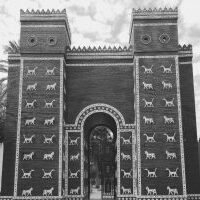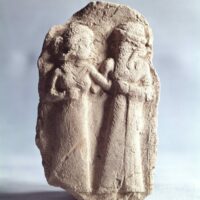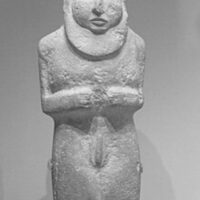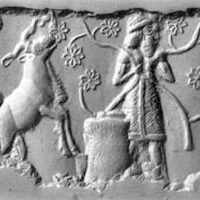Dumuzid : The Shepherd King
Listen
At a glance
| Description | |
|---|---|
| Origin | Sumerian Mythology |
| Classification | Mortals |
| Family Members | Enki (Father), Duttur (Mother), Geshtinanna (Sister) Ishtar/Innana (Wife) |
| Region | Iraq |
| Associated With | Fertility, Abundance, Agriculture |
Dumuzid
Introduction
Dumuzid, also known as Tammuz, holds a significant place in ancient Mesopotamian mythology, particularly associated with agriculture, shepherds, and fertility. He symbolizes the sustenance and well-being of the community, ensuring prosperity for both land and people. Originating from the Early Dynastic III period (around 2600-2334 BCE) in Sumer, Dumuzid was predominantly worshipped in Uruk, a prominent center of Sumerian civilization. His enduring popularity reflects the deep connection Sumerians felt with nature and its rhythms, emphasizing his role in the vital cycle of life and the changing seasons.
Physical Traits
Dumuzid is commonly portrayed as a handsome and youthful deity exuding vitality and strength in ancient Sumerian art. He typically appears as a bearded man adorned with a horned tiara or crown, emphasizing his divine nature. Depictions often show him holding a shepherd’s crook, highlighting his role as a protector and provider for flocks, symbolizing the abundance he brings to his worshippers. While some interpretations suggest he may have also been depicted as a beardless shepherd with a crown of leaves, Dumuzid’s physical appearance is less defined compared to the emotions and symbolism he represents in Sumerian mythology.
Family
Dumuzid’s significance within Sumerian mythology is deeply rooted in his familial ties. He is famously known as the consort of the powerful goddess Inanna, also identified as Ishtar in later Mesopotamian cultures. Inanna, revered for her association with love, war, and fertility, held a central place in Sumerian religious beliefs. Their divine union symbolized the essential balance between feminine and masculine energies, reflecting a fundamental aspect of the natural order.
Additionally, Dumuzid’s sister, Geshtinanna, played a significant role in the pantheon. As the goddess of agriculture, fertility, and dream interpretation, Geshtinanna shared a close bond with her brother, their destinies intricately interwoven in enduring Sumerian myths. The family lineage of Dumuzid is further enriched by his parentage, identified as the son of Enki, the god of water and wisdom, and Duttur.
Dumuzid’s complex family connections underscore his mythological role, particularly as the consort of Inanna, shaping the narrative of pivotal myths like the Descent of Inanna. In various traditions, Dumuzid’s divine lineage as the son of Enki adds depth and significance to his position within the Sumerian pantheon, emphasizing the intertwining relationships and dynamics among the deities of ancient Mesopotamia.
Other names
Dumuzid, the Shepherd God of ancient Mesopotamia, is known by a multitude of names across different cultures and regions of the ancient Near East. In Sumerian, he is referred to as Dumuzid, possibly corresponding to the Babylonian name Du’uzu or the Babylonia and Assyrian name Dumuzi. This deity is also recognized in Hebrew and Arabic as Tammuz, a name that emphasizes his role as the god of shepherds and fertility. The name “Tammuz” can be translated to mean “the good young one,” reflecting Dumuzid’s association with youthfulness and fertility.
The components of Dumuzid’s Sumerian name hold significant meaning. “Dumu” translates to “son” or “young man,” while “zid” can signify “righteous” or “faithful,” collectively portraying Dumuzid as a divine embodiment of youthful vigor and devotion. This understanding extends into Akkadian mythology, where he is more commonly known as Tammuz, a name that gained prominence in later Semitic cultures.
The influence of Dumuzid’s character transcends Mesopotamia, spreading into Phoenician and Canaanite traditions, where he was worshipped extensively in connection with agricultural rites and mourning rituals. The adoption of the name “Adonis” in Greek mythology likely derives from the West Semitic adaptation of Tammuz, illustrating the widespread recognition and adaptation of Dumuzid’s divine persona throughout the ancient Near East.
Powers and Abilities
Dumuzid’s significance in Sumerian mythology is not derived from wielding thunderbolts or commanding mythical creatures but from his profound connection to the natural world and the cycles of life and death. As a deity, Dumuzid embodies the life-giving force of spring and the sustaining power of vegetation crucial to Sumerian agriculture. Beyond his role in fertility and abundance, Dumuzid’s mythological narratives revolve around the cyclical nature of life and the harsh realities of Sumerian summers. The scorching heat and lack of rain during summer mirrored Dumuzid’s descent into the underworld, symbolizing nature’s dormancy and eventual rebirth. This cycle of death and rebirth became central to the myths surrounding him.
Dumuzid’s domain extends beyond agricultural prosperity to encompass themes of kingship, embodying the ideal of a wise and just ruler. His significance lies in representing the natural rhythms observed by ancient agrarian societies, ensuring the well-being of livestock, overseeing seasonal cycles, and symbolizing the essential balance between life, death, and renewal.
Two key narratives, “The Descent of Inanna” and “Dumuzi’s Dream,” further illuminate Dumuzid’s role in Sumerian mythology. “The Descent of Inanna” recounts Inanna’s journey into the underworld, where Dumuzid’s fate becomes entwined with the cycle of life and death. In one version, Dumuzid is dragged to the underworld, while in another, his sister Geshtinanna volunteers to take his place, highlighting the interconnectedness of nature’s cycles.
“Dumuzi’s Dream” foreshadows Dumuzid’s demise through ominous dreams and eventually his capture by demons, leading to his descent into the underworld. These myths underscore Dumuzid’s vital role in maintaining the balance of nature—his death representing the dormancy of summer and the earth, while his return symbolizes the life-giving renewal of spring and agricultural abundance. Through these narratives, Dumuzid emerges as a profound embodiment of the enduring cycles and mysteries of the natural world in ancient Mesopotamian beliefs.
Modern Day Influence
Dumuzid’s enduring influence extends into modern literature and art, captivating creators across various genres with themes of love, sacrifice, and the cycles of life and death. Artists and authors continue to offer fresh perspectives on Dumuzid’s narratives, keeping his relevance alive in contemporary culture.
Across millennia, Dumuzid’s legacy persists in diverse cultural contexts. His role as a dying-and-reviving god parallels motifs found in later mythologies and religions, such as the resurrection of Jesus Christ in Christianity and the story of Osiris in Egyptian mythology. The concept of a sacrificial figure whose death signifies renewal and regeneration remains a prominent theme in literature, art, and folklore.
Moreover, Dumuzid’s association with fertility and rebirth resonates deeply with contemporary environmental movements, emphasizing the importance of sustainable agriculture and ecological balance. His presence in ancient literature continues to inspire scholars and artists, fueling ongoing research and creative interpretations of Mesopotamian mythology in modern times. Through these enduring connections, Dumuzid remains a significant and influential figure in the cultural landscape, bridging ancient traditions with contemporary themes and concerns.
Related Images
Frequently Asked Questions
What is lorem Ipsum?
I am text block. Click edit button to change this text. Lorem ipsum dolor sit amet, consectetur adipiscing elit. Ut elit tellus, luctus nec ullamcorper mattis, pulvinar dapibus leo.
What is lorem Ipsum?
I am text block. Click edit button to change this text. Lorem ipsum dolor sit amet, consectetur adipiscing elit. Ut elit tellus, luctus nec ullamcorper mattis, pulvinar dapibus leo.
What is lorem Ipsum?
I am text block. Click edit button to change this text. Lorem ipsum dolor sit amet, consectetur adipiscing elit. Ut elit tellus, luctus nec ullamcorper mattis, pulvinar dapibus leo.
What is lorem Ipsum?
I am text block. Click edit button to change this text. Lorem ipsum dolor sit amet, consectetur adipiscing elit. Ut elit tellus, luctus nec ullamcorper mattis, pulvinar dapibus leo.
What is lorem Ipsum?
I am text block. Click edit button to change this text. Lorem ipsum dolor sit amet, consectetur adipiscing elit. Ut elit tellus, luctus nec ullamcorper mattis, pulvinar dapibus leo.








